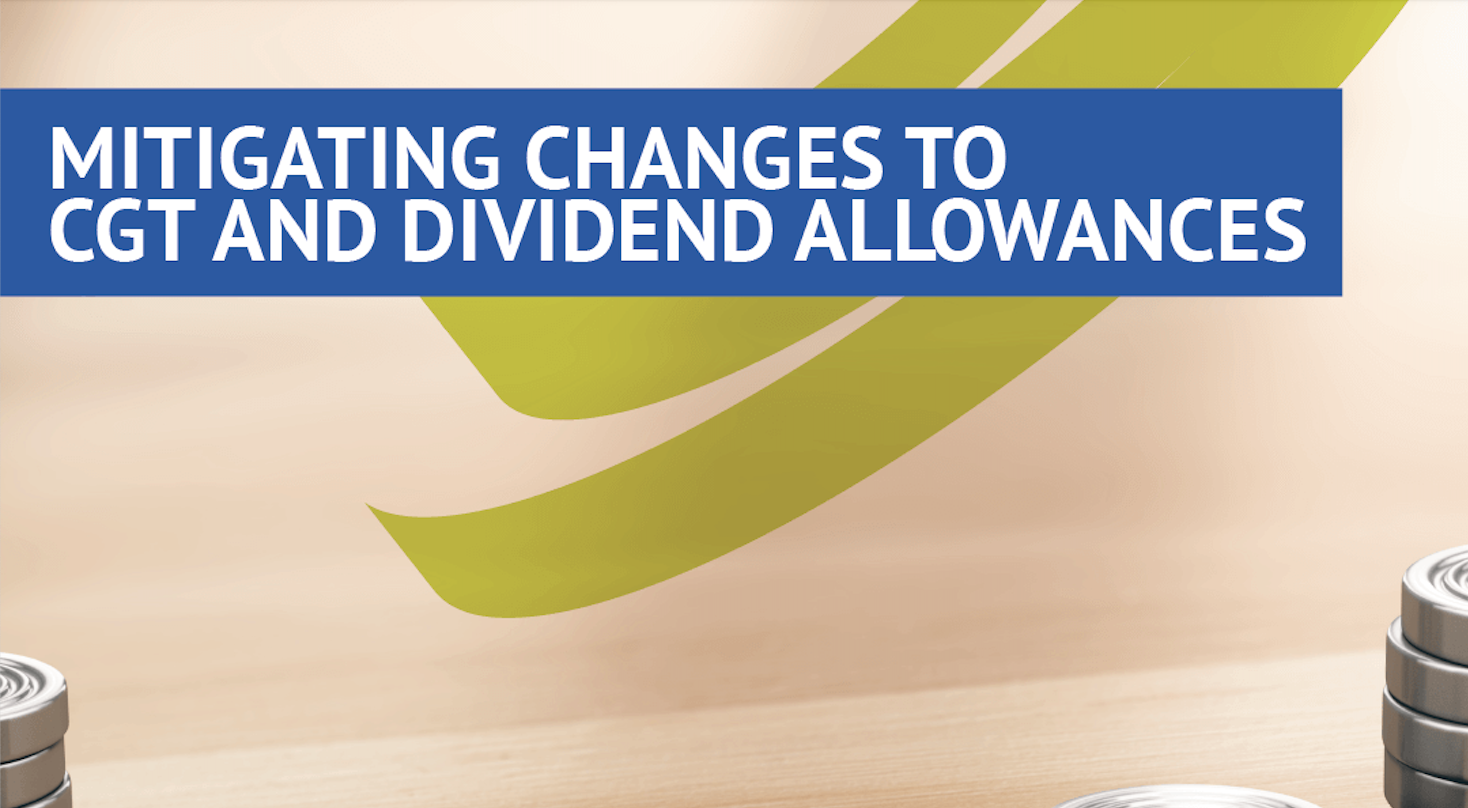Mitigating Changes to Corporation Tax Rates and Dividend Allowance 2023/2024
31st May 2023
With changes to both the rate of Corporation Tax as well as the Dividend Allowance 2023/2024, many Companies and Directors will be looking to reassess the efficiency of previous tax strategies. In our article we explain the changes, how they may impact and outline potential alternatives to traditional Corporation Tax/Dividend income routes
Changes to Corporation Tax Rates
In the UK, all companies are liable to pay Corporation Tax on any profits generated. In April 2023 the rate of Corporation Tax (CT) increased from 19% to 25% for all businesses with profits exceeding £250,000. For businesses with profit less than £50,000 the rate remained unchanged at 19% and for those with profits between £50,001 and £250,000 an effective rate of 26.5% is now applied, using a marginal (or tapered) relief. The impact of this change in CT rate can be seen across these scenarios:
Scenario 1: Company earns £60,000 profit
Annual company profits: £60,000
Corporation tax liability at pre-April 2023 rates: £11,400
Corporation tax liability post-April 2023 rates: £12,150
Additional tax owed: £750
*2023 tax liability calculated on tax rates of 19% for the first £50k, then 26.5% up to £250k, then 25% above £250k. 2022 liability calculated on tax rate of 19%
Scenario 2: Company earns £200,000 profit
Annual company profits: £200,000
Corporation tax liability at pre-April 2023 rates: £38,000
Corporation tax liability post-April 2023 rates: £49,250
Additional tax owed: £11,250
*2023 tax liability calculated on tax rates of 19% for the first £50k, then 26.5% up to £250k, then 25% above £250k. 2022 liability calculated on tax rate of 19%
Scenario 3: Company earns £80,000 profit
Annual company profits: £80,000
Corporation tax liability at pre-April 2023 rates: £15,000
Corporation tax liability post-April 2023 rates: £17,250
Additional tax owed: £2,250
*2023 tax liability calculated on tax rates of 19% for the first £50k, then 26.5% up to £250k, then 25% above £250k. 2022 liability calculated on tax rate of 19%. Marginal relief calculated as follows: Tax on annual profits at 25% (£20,000), then annual profits subtracted from £250,000 threshold (£170,000), before being multiplied by marginal rate multiplier 3/200 (£2,250). Result subtracted from 25% tax rate of £20,000 to give £17,450.
Please note, lower and upper profit thresholds for Corporation Tax are proportionately reduced for short accounting periods – and when associated companies apply.
Changes to the Dividend Allowance 2023/2024
A dividend is a payment made to a shareholder of a limited company from any profit made within the business once all expenses, tax and VAT have been accounted for.
The tax-free dividend allowance 2023/2024 has been reduced from £2,000 to £1,000, meaning a shareholder must now pay tax on any dividends exceeding £1,000.
This has effectively halved the opportunity for tax efficiency using dividends, though the dividend tax rate bands of 8.75% (basic rate up to £37,300), 33.75% (higher rate up to £150,000) and 39.35% (additional rate over £150,000 ) have remained unchanged.
From 2024/2025 this dividend allowance halves again to £500, giving an overall decrease of 90% since its initial introduction in 2016/2017.
The personal allowance for Income Tax has also been frozen at £12,570 for the year 2023/2024.
How Might These Changes Impact You?
Frequently Company Directors have used a mix of personal allowance and dividends, alongside Corporation Tax, to ensure an efficient tax strategy across their business and individual liabilities. Taking a lower salary and a higher dividend has traditionally been a tax-effective combination, due to the flexibility of dividend total allocation, the absence of NICs on dividends and the ability for the company to claim back the cost of the Director’s salary within its own tax calculations. Taking a salary also ensures an NI record for a state pension.
The combination of increased CT rates and a reduced Dividend Allowance 2023/2024 has impacted the efficiency of this strategy. Take this scenario across both the 2022/2023 and 2023/2024 tax years.
Year 2022/23
Company A:
Profits: £90,001 without Director salary deduction. £60,001 with salary deduction.
Director Salary: £12,570
Dividends: £30,000
Director Tax Liability:
No tax due on £12,570 salary as falls within Personal Allowance threshold
Tax due on dividends is £30,000-£2,000 = £28,000. Basic rate of 8.75% = £2,450
Total Income Tax on £42,570 (of which £12,570 is salary and £30,000 is dividends): £2,450
Corporation Tax Liability:
Tax paid at rate of 19% on £60,001 = £11,400
Total Tax Paid across company and Director: £13,850
Year 2023/24
Company A:
Profits: £90,001 without Director salary deduction. £60,001 with salary deduction.
Director Salary: £12,570
Dividends: £30,000
Director Tax Liability:
No tax due on £12,570 salary as falls within Personal Allowance threshold
Tax due on dividends is £30,000-£1,000 = £29,000. Basic rate of 8.75% = £2,537.50
Total Income Tax on £42,570 (of which £12,570 is salary and £30,000 is dividends): £2,537.50
Corporation Tax Liability:
Tax paid at rate of 19% up to £50,001 = £9,500.19 Tax paid at rate of 26.5% between £50,001 and £60,001 = £2,650
Total CT paid: £12,150.19
Total Tax Paid across company and Director: £14,687.69
This equates to a 6% increase in tax paid across the business and Director from year to year on the same level of profits and salary.
In particular, family-led companies that have traditional used an alphabet share structure will see the reduction in dividend allowance impacting ability to withdraw profits from the business in the form of dividends. The changes to Corporation Tax rates will also reduce the available post-tax profits from which dividends can be extracted and the increased rate of corporation tax means that salary and national insurance paid by the company will attract a higher rate of tax relief than previously meaning that a ‘dividend-heavy’ strategy may no longer be the optimum strategy.
What are the alternatives to the traditional route?
For those who have relied on the Personal Allowance/Dividends/Corporation Tax strategy for tax efficiency, it may now be worth reviewing options to ensure that you are optimising all reliefs and allowances available to you. There are several possibilities to explore to build into your individual or corporate tax strategy going forward.
1. Make the most of pension contributions, Self-invested Personal pensions (SIPPs) and Small Self-Administered Schemes (SSASs)
Dividends you receive from pension investments are tax free – and changes announced in the 2023 budget made pensions a more attractive option. With the lifetime allowance now abolished and the annual allowance having increased from £40,000 to £60,000, there is more opportunity to reduce tax liabilities through the effective use of pension investments. Pension contributions also give tax relief at the marginal rate of Income Tax.
SIPPs (Self-Invested Personal Pensions) and SSASs (Small Self-Administered Schemes) are both UK pensions schemes but whereas SIPPs is for investment by individuals, SSASs is an occupational pension scheme. They can prove a tax-efficient option, giving the 0% rate on both the associated dividend and Capital Gains Tax.
2. Use Capital Gains Tax allowance
Capital Gains Tax (CGT) is taxed at a lower rate than Income Tax and, even though the threshold has been reduced for 2023 onwards, it can still offer tax efficiencies for investment and gives increased flexibility around the timing of capital gains.
3. Take advantage of increased Capital Allowances, including AIA and Super Deductions
One of the positive outcomes of the 2023 budget was the introduction of two major capital allowances alongside the announcement of changes to the Annual Investment Allowance.
- Allowing those businesses paying Corporation Tax to deduct 100% of any qualifying plant & machinery expenditure, the Full Expensing (FE) capital allowance is applicable from 1stApril 2023 until 31st March 2026. Using FE, businesses will be able to deduct 100% of the cost of any qualifying expenditure from their profits straight away – rather than over the life of the asset – giving an effective tax saving of up to 25p for every £1 invested.
- The 50% First Year Allowance (FYA) permits eligible businesses to deduct 50% of the cost of any qualifying plant & machinery expenditure from their profits during the first year of purchase, with the remaining balance to be written down at the usual 6% rate in consequent years. The 50% FYA was due to end on 31 March 2023 but it was announced in the budget that it has now been extended until 31st March 2026
- A permanent £1 million threshold for the Annual Investment Allowance was also announced, which amounts to full expensing for 99% of businesses by providing 100% first-year relief for plant and machinery investments up to £1 million. Importantly, the AIA carries no balancing charges on the disposal of assets.
4. Consider investment in an Individual Savings Account (ISA)
Individual Savings Accounts (ISAs) allow individuals to save and invest a certain level of capital each year without paying any tax on the income or capital gains they earn – including dividends. The annual ISA allowance for 2023/24 is £20,000, which can be distributed into a singular or multiple ISAs, but can not be carried forward to future tax years.
5. Utilise the Enterprise Investment Scheme (EIS) and Seed Enterprise Investment Scheme (SEIS)
The Enterprise Investment Scheme (EIS) and Seed Enterprise Investment Scheme (SEIS) were set up by the government to encourage investment in fledgeling companies. Offering Capital Gains Tax exemption, IHT exemption, up to 50% Income Tax relief and capital gains deferral, they give attractive exit terms from any investment in them, though their use and benefits should be considered as part of a longer-term strategy, rather than a direct replacement of annual dividends.
6. Include Partners in Your Tax Strategy
Where one partner’s income may be higher than another’s, it may make sense to allocate a share of any income-generating investment in their name, giving the benefit of an increased overall annual dividend allowance.
Next Steps
The first step in mitigating any negative impact due to changes in the Corporation Tax rate and dividend allowances is to understand how they may specifically impact you and/or your business. Talk to your accountant or financial advisor to help paint a picture of your individual circumstances, before discussing and assessing options that may help you achieve the most tax efficient strategy going forward. Whether making use of increased Capital Allowances at corporate level or investment in schemes such as EIS or ISAs at an individual level, your final tax strategy should make the most of available reliefs and allowances.
The TTRB tax team is a group of qualified and experienced tax professionals, able to expertly assess and explain your options. Call us today to plan your 2023/2024 tax strategy.





